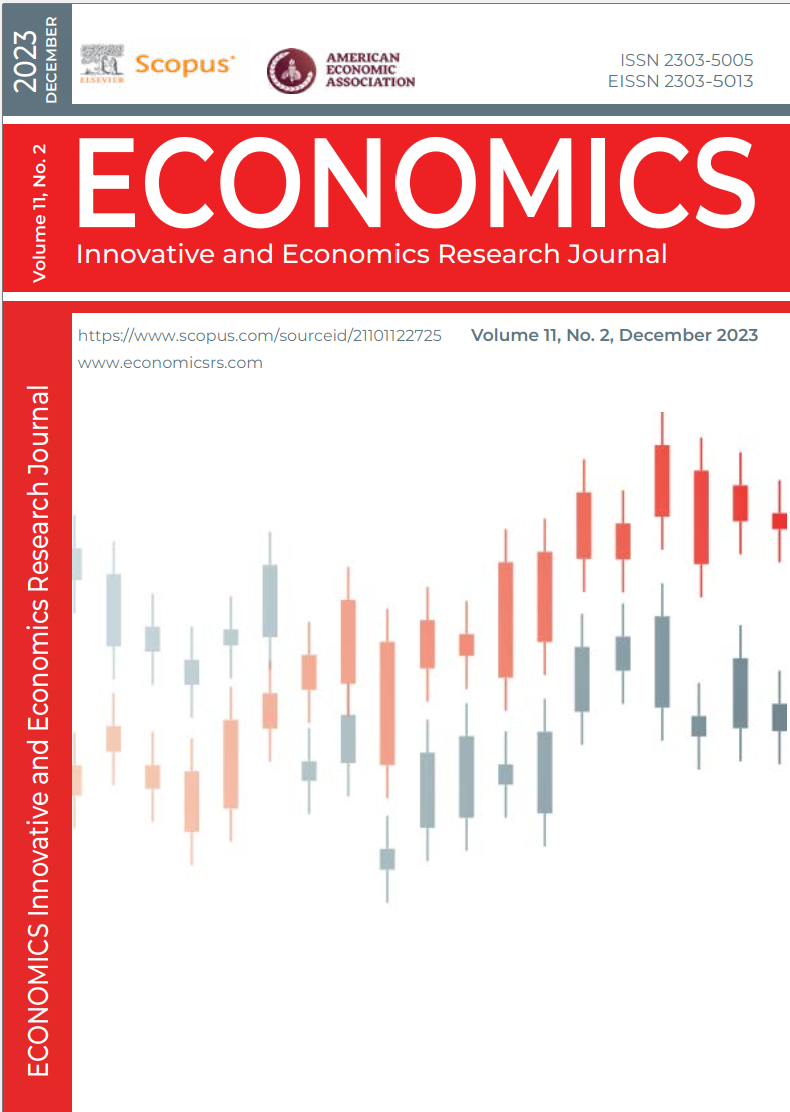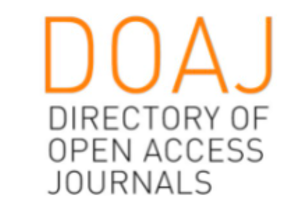ASSESSING THE IMPACT OF OIL PRICE VOLATILITY ON FOOD PRICES IN SAUDI ARABIA: INSIGHTS FROM NONLINEAR AUTOREGRESSIVE DISTRIBUTED LAGS (NARDL) ANALYSIS
DOI:
https://doi.org/10.2478/eoik-2023-0056Keywords:
Food prices, Oil prices, Real GDP, Nonlinear ARDL, Saudi ArabiaAbstract
This research investigates the impact of oil price fluctuations on food prices in Saudi Arabia between 1979 and 2020 using Nonlinear Autoregressive Distributed Lags (NARDL) methodology. The study employs Augmented Dickey Fuller (ADF) and Phillips Perron (PP) tests to determine the integration order of the variables and Bounds testing to confirm the existence of long run cointegration relationships between each variable. The results indicate that oil shocks influence food prices through several mechanisms. Firstly, the cost of energy increases due to the rise in oil prices, affecting the agricultural commodity market, including farm equipment, food processing, packaging, and distribution costs. Secondly, the demand for agricultural commodities to produce biofuels affects food availability and thus food prices. Thirdly, as an oil-based economy, the oil price shock affects food prices through its impact on government spending, which affects aggregate demand and liquidity. Therefore, Saudi Arabia should adopt appropriate policies to mitigate the impact of oil price shocks on food prices, including investing in renewable energy sources, diversifying its economy, and improving food production and supply chain efficiency. Additionally, implementing appropriate fiscal policies to ensure sufficient budget allocation for food support programs is crucial. However, Investing in groundwater exploration can contribute significantly to the development of Saudi agriculture and to gradually achieving food self-sufficiency.
References
Alghalith, M. (2010). The interaction between food prices and oil prices. Energy Economics, 32(6), 1520-1522. doi.org/10.1016/j.eneco.2010.08.012
Alsahafi, M. (2009). Linear and non-linear techniques for estimating the money demand function: The case of Saudi Arabia (Doctoral dissertation, University of Kansas). https://kuscholarworks.ku.edu/handle/1808/5651
Alom, F., Ward, B. D., & Hu, B. (2011). Spillover effects of World oil prices on food prices: evidence for Asia and Pacific countries. https://hdl.handle.net/10182/4526
Amolegbe, K. B., Upton, J., Bageant, E., & Blom, S. (2021). Food price volatility and household food security: Evidence from Nigeria. Food Policy, 102. doi.org/10.1016/j.foodpol.2021.102061
Baffes, J. (2007). Oil spills on other commodities. Resources Policy, 32(3), 126-134. doi.org/10.1016/j.resourpol.2007.08.004
Basher, S. A., & Elsamadisy, E. M. (2012). Country heterogeneity and long‐run determinants of inflation in the Gulf Arab states. OPEC Energy Review, 36(2), 170-203. https://doi.org/10.1111/j.1753-0237.2011.00208.x
Basher, S. A., & Fachin, S. (2014). Investigating long-run demand for broad money in the Gulf Arab countries. Middle East Development Journal, 6(2), 199-214. https://doi.org/10.1080/17938120.2014.961330
Baumeister, C., & Kilian, L. (2014). Do oil price increases cause higher food prices?. Economic Policy, 29(80), 691-747. https://doi.org/10.1111/1468-0327.12039
Cavallo, M. (2008). Oil Prices and Inflation, Federal Reserve Bank of San Francisco. FRBSF. Economic Letter, 31(3).
Cecchetti, S. (2000). Making monetary policy: Objectives and rules. Oxford Review of Economic Policy, 16(4), 43-59. https://doi.org/10.1093/oxrep/16.4.43
House, C. (2013). Global food insecurity and implications for Saudi Arabia. Energy, Environment and Resources Summary. Chatham House, London, 1-10. https://www.chathamhouse.org/sites/default/files/public/Research/Energy,%20Environment%20and%20Development/290413summary.pdf
Chen, S. S. (2009). Oil price pass-through into inflation. Energy economics, 31(1), 126-133. https://doi.org/10.1016/j.eneco.2008.08.006
Chikhi M.,Bouchetara M. and Zerouti M. (2022). Factors of investment in renewable energy and energy efficiency in Algeria. ECONOMICS- Innovative and Economics Research Journal, 10(2), 161- 181. https://doi.org/10.2478/eoik-2022-0020
Clark, T. E., & Terry, S. J. (2010). Time variation in the inflation passthrough of energy prices. Journal of Money, credit and Banking, 42(7), 1419-1433. https://doi.org/10.1111/j.1538-4616.2010.00347.x
Cunado, J., & De Gracia, F. P. (2005). Oil prices, economic activity and inflation: evidence for some Asian countries. The Quarterly Review of Economics and Finance, 45(1), 65-83. https://doi.org/10.1016/j.qref.2004.02.003
Dancy, J. (2012). Food Prices Mirror Oil Prices: The Crude Oil-FAO Food Price Index Price Correlation.e Financial sense, 14. https://www.financialsense.com/contributors/joseph-dancy/food-prices-mirror-oil-prices-thecrude-oil-fao-food-price-index-price-correlation
Delatte, A. L., & López-Villavicencio, A. (2012). Asymmetric exchange rate pass-through: Evidence from major countries. Journal of Macroeconomics, 34(3), 833-844. https://doi.org/10.1016/j.jmacro.2012.03.003
Ding, C., Gummi, U. M., Lu, S. B., & Muazu, A. (2020). Modelling the impact of oil price fluctuations on food price in high and low-income oil exporting countries. Agricultural Economics, 66(10), 458-468. https://doi.org/10.17221/197/2020-AGRICECON
Derouez, F., Adel, I., Bayomei, S., Ahmed, S., & Alrawad, M. (2023). The effect of spatial distribution on the composition of the middle social class in the Kingdom of Saudi Arabia: A spatial econometric analysis. Computers in Human Behavior Reports, 11. https://doi.org/10.1016/j.chbr.2023.100316
US Energy Information Administration. (2014). Country Analysis Brief: Saudi Arabia. Esmaeili, A., & Shokoohi, Z. (2011). Assessing the effect of oil price on world food prices: Application of principal component analysis. Energy Policy, 39(2), 1022-1025. https://doi.org/10.1016/j.enpol.2010.11.004
Erkişi K. and Boğa S. (2023). Does Financial Inclusion Improve Income Equality? The Case of Türkiye. ECONOMICS- Innovative and Economics Research Journal, 11(2). https://doi.org/10.2478/eoik-2023-0049
Gordon, R. J. (1981). Inflation, flexible exchange rates, and the natural rate of unemployment (No. w0708). National Bureau of Economic Research. doi.org/10.3386/w0708
Gordon, Robert J. (1990). U.S. Inflation, Labor’s Share, and the Natural Rate of Unemployment. In Economics of Wage Determination, ed. Heinz Konig, New York: Springer-Verlag, 1–34. doi.org/10.3386/w2585
De Gregorio, J., Landerretche, O., Neilson, C., Broda, C., & Rigobon, R. (2007). Another pass-through bites the dust? Oil prices and inflation [with comments]. Economia, 7(2), 155-208. https://www.jstor.org/stable/20060494
Hooker, M. A. (2002). Are oil shocks inflationary? Asymmetric and nonlinear specifications versus changes in regime. Journal of money, credit and banking, 540-561. https://www.jstor.org/stable/3270701
Ibrahim, M. H. (2015). Oil and food prices in Malaysia: a nonlinear ARDL analysis. Agricultural and Food Economics, 3(1), 1-14. https://doi.org/10.1186/s40100-014-0020-3
Ibrahim, M. H., & Chancharoenchai, K. (2014). How inflationary are oil price hikes? A disaggregated look at Thailand using symmetric and asymmetric cointegration models. Journal of the Asia Pacific Economy, 19(3), 409-422. https://doi.org/10.1080/13547860.2013.820470
Ibrahim, M. H., & Said, R. (2012). Disaggregated consumer prices and oil price pass‐through: evidence from Malaysia. China agricultural economic review, 4(4), 514-529. https://doi.org/10.1108/17561371211284858
Idris A.,Hanafi M.,Rahmawati A. and Surwanti A. (2023). Impact of Intellectual Capital and Risk Attitude Through Financial Literacy on Business Sustainability in Indonesia Batik Smes. ECONOMICS- Innovative and Economics Research Journal, 11(2). https://doi.org/10.2478/eoik-2023-0052
Karimi, M., Kaliappan, S. R., & Matemilola, B. T. (2014). World Oil Price and Food Prices in US: Evidence from the Threshold Cointegration Models. The Empirical Economics Letters, 13(10). http://www.eel.my100megs.com/volume-13-number-10.htm
Lizardo, R. A., & Mollick, A. V. (2010). Oil price fluctuations and US dollar exchange rates. Energy Economics, 32(2), 399-408. https://doi.org/10.1016/j.eneco.2009.10.00
Lauvsnes, S. O., & Ingulfsvann, A. (2023). Dutch disease and agriculture in Norway revisited: The oil price, food imports, resource and sustainability nexus. Journal of Cleaner Production. https://doi.org/10.1016/j.jclepro.2023.138934
Lucas, R. E. (1973). Some international evidence on output-inflation tradeoffs. The American economic review, 326-334. https://www.jstor.org/stable/1914364
Lutfi, A., Ashraf, M., Watto, W. A., & Alrawad, M. (2022). Do Uncertainty and Financial Development Influence the FDI Inflow of a Developing Nation? A Time Series ARDL Approach. Sustainability, 14(19). https://doi.org/10.3390/su141912609
Mohammed, S., Ibrahim, U. S., & Abubakar, N. (2014). Effect of hike in food prices on household food expenditure in kano State, Nigeria: a case of 2008 global food crisis. Agriculture and Biology Journal of North America, 5(4), 155-159.
Nazlioglu, S., & Soytas, U. (2011). World oil prices and agricultural commodity prices: Evidence from an emerging market. Energy Economics, 33(3), 488-496. https://doi.org/10.1016/j.eneco.2010.11.012
Pal, D., & Mitra, S. K. (2020). Time-frequency dynamics of return spillover from crude oil to agricultural commodities. Applied Economics, 52(49), 5426-5445. https://doi.org/10.1080/00036846.2020.1764482
Pesaran, M. H., Shin, Y., & Smith, R. J. (2001). Bounds testing approaches to the analysis of level relationships. Journal of applied econometrics, 16(3), 289-326. https://doi.org/10.1002/jae.616
Pesaran, M. H., & Shin, Y. (1995). An autoregressive distributed lag modelling approach to cointegration analysis, 9514. Cambridge Working papers in Economics 9514, University of Cambridge. https://ideas.repec.org/p/cam/camdae/9514.html
Podlevska O. and Podlevskyi A. (2023). Development of Circular Economy in Modern Conditions. ECONOMICS- Innovative and Economics Research Journal, 11(2). https://doi.org/10.2478/eoik-2023-0025
Raza, S. A., Guesmi, K., Belaid, F., & Shah, N. (2022). Time-frequency causality and connectedness between oil price shocks and the world food prices. Research in International Business and Finance, 62. https://doi.org/10.1016/j.ribaf.2022.101730
Scheibe, J. (2005). Vines DA Phillips curve for China. CAMA Working Paper, 2. https://cama.crawford.anu.edu.au/sites/default/files/publication/cama_crawford_anu_edu_au/2021-06/2_scheibe_vines_2005.pdf
Shin, Y., Yu, B., & Greenwood-Nimmo, M. (2014). Modelling asymmetric cointegration and dynamic multipliers in a nonlinear ARDL framework. Festschrift in honor of Peter Schmidt: Econometric methods and applications, 281-314. https://link.springer.com/chapter/10.1007/978-1-4899-8008-3_9
Shokoohi, Z., & Saghaian, S. (2022). Nexus of energy and food nutrition prices in oil importing and exporting countries: A panel VAR model. Energy, 255. https://doi.org/10.1016/j.energy.2022.124416
Sun, Y., Gao, P., Raza, S. A., Shah, N., & Sharif, A. (2023). The asymmetric effects of oil price shocks on the world food prices: Fresh evidence from quantile-on-quantile regression approach. Energy, 270. https://doi.org/10.1016/j.energy.2023.126812
Siagian P. (2023). Determinants of Banking Operational Efficiency and the Relationship Between the Factors to Market Price: Evidence from Indonesia. ECONOMICS- Innovative and Economics Research Journal, 11(2). https://doi.org/10.2478/eoik-2023-0051
Chou, Kuo-Wei;Tseng, Yi-Heng (2011). Oil price pass-through into CPI inflation in Asian emerging countries: the discussion of dramatic oil price shocks and high oil price periods. British Journal of Economics, Finance and Management Sciences 2(1), 1-13. http://fguir.fgu.edu.tw:8080/handle/039871000/3744
Yousif, I. E. A. K., & Al-Kahtani, S. H. (2014). Effects of high food prices on consumption pattern of Saudi consumers: A case study of Al Riyadh city. Journal of the Saudi Society of Agricultural Sciences, 13(2), 169-173. https://doi.org/10.1016/j.jssas.2013.05.003
Ujkani X. and Gara A. (2023). Determinants of the Inflation Rate: Evidence from Panel Data. ECONOMICS- Innovative and Economics Research Journal, 11(2). https://doi.org/10.2478/eoik-2023-0054
Downloads
Published
How to Cite
Issue
Section
License
Copyright (c) 2023 ECONOMICS - INNOVATIVE AND ECONOMICS RESEARCH JOURNAL

This work is licensed under a Creative Commons Attribution-NonCommercial-NoDerivatives 4.0 International License.























